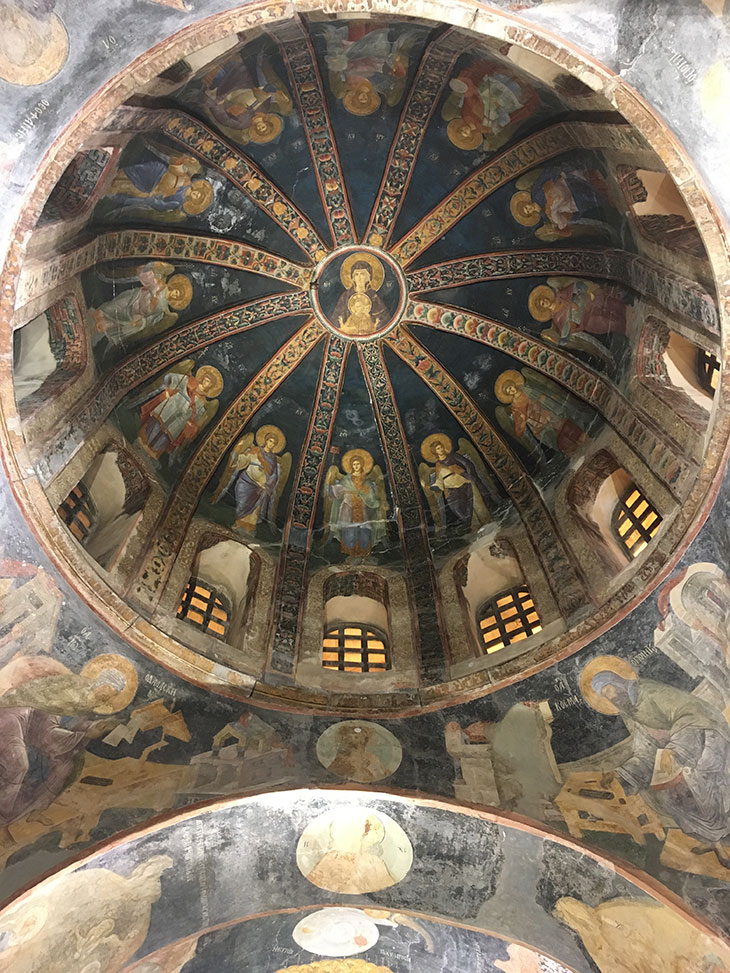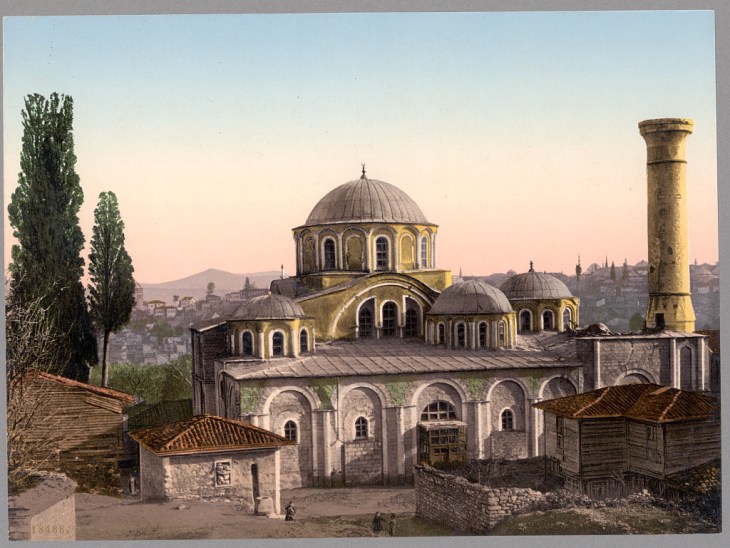In one way or another, all nations exploit their cultural heritage for political reasons. Perhaps the most extreme contemporary example is Turkey where, in November 2019, the country’s top administrative court ruled the use of the Kariye Camii (mosque) in Istanbul as a museum unlawful on the grounds that it violates the Ottoman decree dedicating it to Muslim worship.
The structure was originally the Church of Christ in the Chora Monastery in Byzantine Constantinople, which took its current form in c. 1316–21 under the patronage of Theodore Metochites (1270–1328), the ‘prime minister’ to the Byzantine emperor Andronikos II and a true polymath, who authored hundreds of essays on philosophy, theology, and astronomy. Metochites expanded and renovated the church, furnishing it also with superb mosaics and wall paintings that reflect his taste and erudition. Considered as a masterpiece even in its own time, the decorative programme of the Kariye is a pivotal monument of the ‘proto-Renaissance’, comparable to the early 14th-century fresco programme of Giotto at the Arena Chapel in Padua.
Following the Ottoman conquest of the city in 1453, the Byzantine church was appropriated for Muslim worship and its frescoes and mosaics were gradually (never completely) covered by a thin layer of dye and lime. After the building was declared a national monument in 1945 under the secular Turkish republic, the Kariye Camii underwent a major conservation program, which restored the 14th-century Byzantine paintings and mosaics to their original splendour. Today the Kariye Camii Museum is a major tourist destination in Istanbul.
The decision to return the Kariye (or Chora) Museum from its non-confessional status to a mosque is a populist one intended to appeal to the pious, nationalistic base of Recep Tayyip Erdoğan’s AKP (Justice and Development Party).The transformation of Byzantine churches into mosques is the ultimate manifestation of AKP’s neo-Ottomanist vision, its main legitimising cultural policy. If the court’s verdict is indeed implemented, it sets a clear precedent for the most politically charged landmark of the city: Hagia Sophia, the liturgical and political centre of Byzantine Constantinople, which was claimed as the imperial mosque by the Ottoman sultan Mehmed II in 1453 and has been serving as a museum since 1934.

The Virgin and Child with Angels in the dome of the parecclesion of the church. Photo: Sophie Barling
The Kariye Museum itself will be following the course of the Hagia Sophia of Iznik (Nicaea) and its namesake in Trebizond – both of which served as museums until they were transformed into mosques in 2011 and 2013, respectively. Since then, colleagues in Turkey have reported that the wall paintings in Iznik, already in a derelict state, are being left to decay and the better-preserved 13th-century examples in Trebizond are now hidden behind curtains. There are rumours that due to declining revenues from tourism, the culture ministry is considering the installation of remote-controlled panels or shutters to reveal the mosaics outside of prayer times – a problematic strategy that would create pockets of humidity and could damage or stain the wall surfaces. There is evidently a great conflict of interest at play, when the interventions needed to make the Byzantine churches fitting for a Muslim congregation are detrimental to the conservation of the art they contain.
In the mosaic panel over the entrance door to the Kariye, Theodore Metochites is represented on his knees, presenting his church to the enthroned Christ. He is clad in a sumptuous silk caftan and wears a prominent turban, which is padded and covered with white silk highlighted with gold stripes. To a Byzantine viewer, the representation of Metochites’s sumptuous dress was, first and foremost, a signifier of the donor’s enormous wealth, which made the restoration and decoration of the Chora monastery possible. For a contemporary visitor to the Kariye Museum today, Metochites’s dress is also visual testimony to the artistic and material exchanges between Byzantium and the Islamic world and to the intertwined histories of Christians and Muslims during the Middle Ages. The 14th-century Byzantine statesman’s eagerness to display his taste for contemporary Islamic fashion provides a contrast to the current Turkish regime’s growing unwillingness to embrace the Byzantine cultural heritage as its own.

A photomechanical print of the Kariye Camii from c. 1890–1900. Photo: Library of Congress, Prints and Photographs Division, Washington, D.C.
‘I made the monastery a treasury of countless books of various sorts […] Thus does the monastery forever possess this […] great universal work of philanthropy, at the disposition of all mortals […] for the common use of all men.’ These were the hopes of Theodore Metochites, who, in addition to the extensive decorative programme, furnished the monastery with an impressive library. Only a fraction of the monastery’s precious manuscripts have survived. Its splendid mosaics and wall paintings, on the other hand, are in fairly good condition – thanks to a number of well-funded restorations – and are still in view for all humankind to marvel at. However, some of the finest examples of Byzantine monumental art we admire today may cease to be ‘at the disposition of all mortals’, if the 14th-century Byzantine monument falls victim to contemporary politics.
Lead image: used under Creative Commons licence (CC BY 2.0; original image cropped)

The Kariye Museum in Istanbul – a Byzantine masterpiece under threat
Mosaic of the Enthroned Christ and the Donor, Theodore Metochites above the entrance to the naos of the Kariye (Chora) Museum, Istanbul. Photo: Brad Hostetler (Creative Commons via Flickr)
Share
In one way or another, all nations exploit their cultural heritage for political reasons. Perhaps the most extreme contemporary example is Turkey where, in November 2019, the country’s top administrative court ruled the use of the Kariye Camii (mosque) in Istanbul as a museum unlawful on the grounds that it violates the Ottoman decree dedicating it to Muslim worship.
The structure was originally the Church of Christ in the Chora Monastery in Byzantine Constantinople, which took its current form in c. 1316–21 under the patronage of Theodore Metochites (1270–1328), the ‘prime minister’ to the Byzantine emperor Andronikos II and a true polymath, who authored hundreds of essays on philosophy, theology, and astronomy. Metochites expanded and renovated the church, furnishing it also with superb mosaics and wall paintings that reflect his taste and erudition. Considered as a masterpiece even in its own time, the decorative programme of the Kariye is a pivotal monument of the ‘proto-Renaissance’, comparable to the early 14th-century fresco programme of Giotto at the Arena Chapel in Padua.
Fresco of the Anastasis in the apse of the parecclesion of the church. Photo: Harold Litwiler/Flickr (used under Creative Commons licence [CC. BY 2.0])
Following the Ottoman conquest of the city in 1453, the Byzantine church was appropriated for Muslim worship and its frescoes and mosaics were gradually (never completely) covered by a thin layer of dye and lime. After the building was declared a national monument in 1945 under the secular Turkish republic, the Kariye Camii underwent a major conservation program, which restored the 14th-century Byzantine paintings and mosaics to their original splendour. Today the Kariye Camii Museum is a major tourist destination in Istanbul.
The decision to return the Kariye (or Chora) Museum from its non-confessional status to a mosque is a populist one intended to appeal to the pious, nationalistic base of Recep Tayyip Erdoğan’s AKP (Justice and Development Party).The transformation of Byzantine churches into mosques is the ultimate manifestation of AKP’s neo-Ottomanist vision, its main legitimising cultural policy. If the court’s verdict is indeed implemented, it sets a clear precedent for the most politically charged landmark of the city: Hagia Sophia, the liturgical and political centre of Byzantine Constantinople, which was claimed as the imperial mosque by the Ottoman sultan Mehmed II in 1453 and has been serving as a museum since 1934.
The Virgin and Child with Angels in the dome of the parecclesion of the church. Photo: Sophie Barling
The Kariye Museum itself will be following the course of the Hagia Sophia of Iznik (Nicaea) and its namesake in Trebizond – both of which served as museums until they were transformed into mosques in 2011 and 2013, respectively. Since then, colleagues in Turkey have reported that the wall paintings in Iznik, already in a derelict state, are being left to decay and the better-preserved 13th-century examples in Trebizond are now hidden behind curtains. There are rumours that due to declining revenues from tourism, the culture ministry is considering the installation of remote-controlled panels or shutters to reveal the mosaics outside of prayer times – a problematic strategy that would create pockets of humidity and could damage or stain the wall surfaces. There is evidently a great conflict of interest at play, when the interventions needed to make the Byzantine churches fitting for a Muslim congregation are detrimental to the conservation of the art they contain.
In the mosaic panel over the entrance door to the Kariye, Theodore Metochites is represented on his knees, presenting his church to the enthroned Christ. He is clad in a sumptuous silk caftan and wears a prominent turban, which is padded and covered with white silk highlighted with gold stripes. To a Byzantine viewer, the representation of Metochites’s sumptuous dress was, first and foremost, a signifier of the donor’s enormous wealth, which made the restoration and decoration of the Chora monastery possible. For a contemporary visitor to the Kariye Museum today, Metochites’s dress is also visual testimony to the artistic and material exchanges between Byzantium and the Islamic world and to the intertwined histories of Christians and Muslims during the Middle Ages. The 14th-century Byzantine statesman’s eagerness to display his taste for contemporary Islamic fashion provides a contrast to the current Turkish regime’s growing unwillingness to embrace the Byzantine cultural heritage as its own.
A photomechanical print of the Kariye Camii from c. 1890–1900. Photo: Library of Congress, Prints and Photographs Division, Washington, D.C.
‘I made the monastery a treasury of countless books of various sorts […] Thus does the monastery forever possess this […] great universal work of philanthropy, at the disposition of all mortals […] for the common use of all men.’ These were the hopes of Theodore Metochites, who, in addition to the extensive decorative programme, furnished the monastery with an impressive library. Only a fraction of the monastery’s precious manuscripts have survived. Its splendid mosaics and wall paintings, on the other hand, are in fairly good condition – thanks to a number of well-funded restorations – and are still in view for all humankind to marvel at. However, some of the finest examples of Byzantine monumental art we admire today may cease to be ‘at the disposition of all mortals’, if the 14th-century Byzantine monument falls victim to contemporary politics.
Lead image: used under Creative Commons licence (CC BY 2.0; original image cropped)
Unlimited access from just $16 every 3 months
Subscribe to get unlimited and exclusive access to the top art stories, interviews and exhibition reviews.
Share
Recommended for you
Church, mosque and museum – the Hagia Sophia could be all things to all people
The status of the Byzantine church turned mosque turned museum shows no sign of being settled – but perhaps it shouldn’t be
Why Ottoman style is in vogue in Erdogan’s Turkey
Ottomanism is in and modernism is out – as the state of three mosques shows
Eye of the beholder – how the Prophet Muhammad has been depicted through the centuries
Museums have avoided displaying images of the Prophet in recent years – but might this not do a disservice to the heritage of Islam?